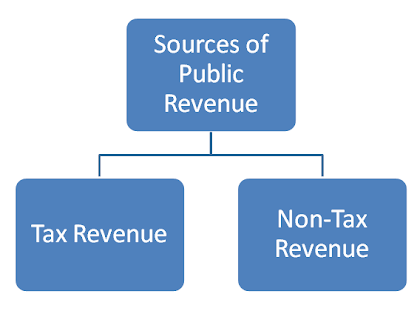Tax and Non-Tax Sources of Public Revenue To Government
 Introduction To Public Revenue ↓
Introduction To Public Revenue ↓
Governments need to perform various functions in the field of political, social & economic activities to maximise social and economic welfare. In order to perform these duties and functions government require large amount of resources. These resources are called Public Revenues.
Public revenue, consists of taxes, revenue from administrative activities like fines, fees, gifts & grants. Public revenue can be classified into two types.
 Tax Revenue ↓
Tax Revenue ↓
Taxes are the first and foremost sources of public revenue. Taxes are compulsory payments to government without expecting direct benefit or return by the tax payer. Taxes collected by Government are used to provide common benefits to all mostly in form of public welfare services. Taxes do not guarantee any direct benefit for person who pays the tax. It is not based on direct quid pro quo principle.
Characteristics of Tax ↓
The following are the characteristics of a tax :-
- A tax is a compulsory payment made to the government. People on whom a tax is imposed must pay the tax. Refusal to pay the tax is a punishable offence.
- There is no quid pro quo between a taxpayer and public authorities. This means that the tax payer cannot claim any specific benefit in return for the payment of a tax.
- Every tax involves some sacrifice on part of the tax payer.
- A tax is not levied as a fine or penalty for breaking law.
The government collect tax revenue by way of direct & indirect taxes. Direct taxes includes; Corporate tax; personal income tax capital gain tax and wealth tax. Indirect taxes includes custom duty, central excise duty, VAT and service tax.
In 2006-07 (India related), the tax revenue contributed about 81% of the total revenue receipts of the central government, whereas non-tax revenue receipts contributed the remaining 19%.
 Non-Tax Revenue ↓
Non-Tax Revenue ↓
The revenue obtained by the government from sources other then tax is called Non-Tax Revenue. The sources of non-tax revenue are :-
1. Fees
Fees are another important source of revenue for the government. A fee is charged by public authorities for rendering a service to the citizens. Unlike tax, there is no compulsion involved in case of fees. The government provides certain services and charges certain fees for them. For example, fees are charged for issuing of passports, driving licenses, etc.
2. Fines or Penalties
Fines or penalties are imposed as a form of punishment for breach of law or non fulfillment or certain conditions or for failure to observe some regulations. Like taxes, fines are compulsory payments without quid pro quo. But while taxes are generally imposed to collect revenue. Fines are imposed as a form of punishment or to prevent people from breaking the law. They are not expected to be a major source of revenue to the government.
3. Surplus from Public Enterprises
The Government also gets revenue by way of surplus from public enterprises. In India, the Government has set up several public sector enterprises to provide public goods and services. Some of the public sector enterprises do make a good amount of profits. The profits or dividends which the government gets can be utilized for public expenditure. There is some sort of quid-pro-quo in the case of surplus from public enterprises. This is because, the public gets goods and services, and the government gets prices, and consequently profits from selling such goods and services.
4. Special assessment of betterment levy
It is a kind of special charge levied on certain members of the community who are beneficiaries of certain government activities or public projects. For example, due to a public park in a locality or due to the construction of a road, people in that locality may experience an appreciation in the value of their property or land. Thus, due to public expenditure, some people may experience 'unearned increments' in their asset holding. Betterment levy is like a tax because it is a compulsory payment, but unlike a tax, in case of betterment levy there is some element of quid pro quo.
5. Grants and Gifts
Gifts are Voluntary contributions by individuals or institutions to the government. Gifts are significant source of revenue during war and emergency.
A grant from one government to another is an important sources of revenue in the modern days. The government at the Centre provides grants to State governments and the State governments provide grants to the local government to carry out their functions.
Grants from foreign countries are known as Foreign Aid. Developing countries receive military aid, food aid, technological aid, etc. from developed countries.
6. Deficit Financing
Deficit means an excess of public expenditure over public revenue.
This excess may be met by borrowings from the market, borrowings from abroad, by the central bank creating currency. In case of borrowing from abroad, there cannot be compulsion for the lenders, but in case of internal borrowings there may be compulsion. The government may force various individuals, firms and institutions to lend to it at a much lower rate than the market would have offered.

No Comment Yet
Please Comment